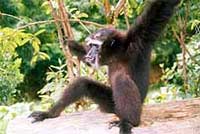The Hoolock/White-browed Gibbon Hylobates hoolock (Harlan, 1834)
Status: Endangered, Schedule I
The only ape of India ‘the hoolock gibbon’ was formerly widespread from eastern India, through Bangladesh to China and south to the Irrawaddy in Myanmar. In 1967 it was reported
to occur in Assam, upper Myanmar, Tenasserim, northern Thailand and northern Laos. By 1987 it had declined drastically, particularly in Bangladesh and India, and was thought to be located in India, the east of Bangladesh, Myanmar, and Yunnan Province in China.
Currently it is thought to occur in the forests of north east India, Bangladesh (east of the Brahmaputra River), south Yunnan (China), and Myanmar (WCMC/WWF 1997z). and may occur in Laos (IUCN 1996). In India it is found in all the seven states of north east
India, mainly the south of Brahmaputra river. A small population was introduced in Mahananda Wildlife Sanctuary in Darjeeling district during 1965.
 In India population estimate comes to 6,200-6,700 individuals utilizing about 4,500 sq km of good habitat and 2,500-3,500 sq km of degraded habitats with
the density of 1.1 and 0.5 per sq km, respectively.
In India population estimate comes to 6,200-6,700 individuals utilizing about 4,500 sq km of good habitat and 2,500-3,500 sq km of degraded habitats with
the density of 1.1 and 0.5 per sq km, respectively.
Major threats to this species include the rapid deforestation, poor environmental education, the absence of conservation measures agriculture including tea plantations.
In recent years, several sanctuaries and reserves that lie inside the Hoolock gibbon's natural range have been created, however the increased problem of habitat fragmentation is still of much concern (Wolfheim, 1983). Habitat destruction through shifting cultivation
by hill tribes and logging has created a fragmented habitat.
Gibbons are forced to descend from trees to cross clearings making them vulnerable to hunting and predation.
Intense hunting of gibbons by local tribes is reported in Assam. Gibbon meat and bones are of value as a tonic in some traditional Asian medicines. Home range of hoolock gibbon may vary from 18 to 30 ha with a mean of 22 ha (Choudhury,
1989).
Average life expectancy is 40 years (Rowe, 1996). The hoolock gibbon gives birth to a single offspring. A single young is born every 2 - 3 years. Mating takes place during
rainy season. Gestation period varies from seven (7) to eight (8) months. Normally a single young is born, sometimes twins, every 2-3 years. Birth typically occurs from November to March. The estrous cycle averages is of 28 days. After the young is born, it
clings tightly to the mother around the waist and remains there for the first few months of its life. Gradual weaning will occur in 1.5-2 years and the young usually reach sexual maturity in 84 months (Rowe, 1996), although gibbons in captivity are known to
have reached maturity at 6-7 years of age.
Like all gibbon species, Hylobates hoolock is monogamous (Nowak, 1999). The mated pair, along with their offspring (typically one or two), occupy a fiercely defended and
stable territory. Occasionally, lone adults--usually sub-adults recently forced from their family group--will establish solitary territories. In Assam and Bangladesh, the Hoolock gibbon's average territory size is 22 ha (Nowak, 1999)
Courtship in gibbons is described thus:
'The male initiates a long solo with an elaborate introduction and a short interlude. The female soon joins in for a duet, and the crescendo is reached with the great call.
He simultaneously swings hand-over-hand, from tree to tree, over distances of more than ten metres - spectacular gymnastics for an animal without a tail and splendid stereo-surround! Once the female reciprocates, she dominates the rest of the concert. The
gibbons transmit, through song, information about species, sex and parental territory. This communication helps the pair bond for life.' ( Sanctuary)
Shy and diurnal, Hoolock Gibon is almost arboreal, mainly feeds above 15m from ground (Choudhury, 1989). Like other gibbon species it is basically frugivorous, only one (1)
percent of its feeding time is being spent on insect (Tilson, 1979). It was observed feeding on the fruits of Ficus hispida. It feeds with both hands sitting on a tree branches, or with one hand by hanging from a tree branch. Generally frugivorous, but the
diet may be mixed with insects, leaves, and other vegetable matter. Usually ripe, pulpy fruit is preferred, so gibbons compete mainly with squirrels and birds, rather than other primates. Small vertebrates and eggs may be eaten occasionally. Generally, about
35 percent of the daily activity is spent on feeding, and of that, up to 65 percent of the time is spent on foraging for fruit (Chivers, 1977).
It survives only in undisturbed forests and occupy upper canopy. This species sleeps and rests in the emergent trees (Leighton, 1987). All gibbons are arboreal
and diurnal. The hoolock gibbon is a good swimmer and frequenty uses riparian habitats. It takes shelter in the shady trees during the hot hours of the day while at night it sleeps in the top canopy of tall trees. This species lives in undisturbed primary
forests, evergreen forests, mixed evergreen forests, scrub forests, subtropical monsoon forests, and humid mountainous broad leaf evergreen forests throughout their natural range. The tall trees of deciduous species in semi-evergreen forests provide it vantage
place for sub-wasking. Hoolock gibbons usually prefer undisturbed forested areas and are found at elevations ranging from 152 to 1370m (Wolfheim, 1983).
Hoolock Gibbon is the state animal of Mizoram. The singing and whistling
Hoolock gibbons are now under serious threat from extensive deforestation and hunting of apes.